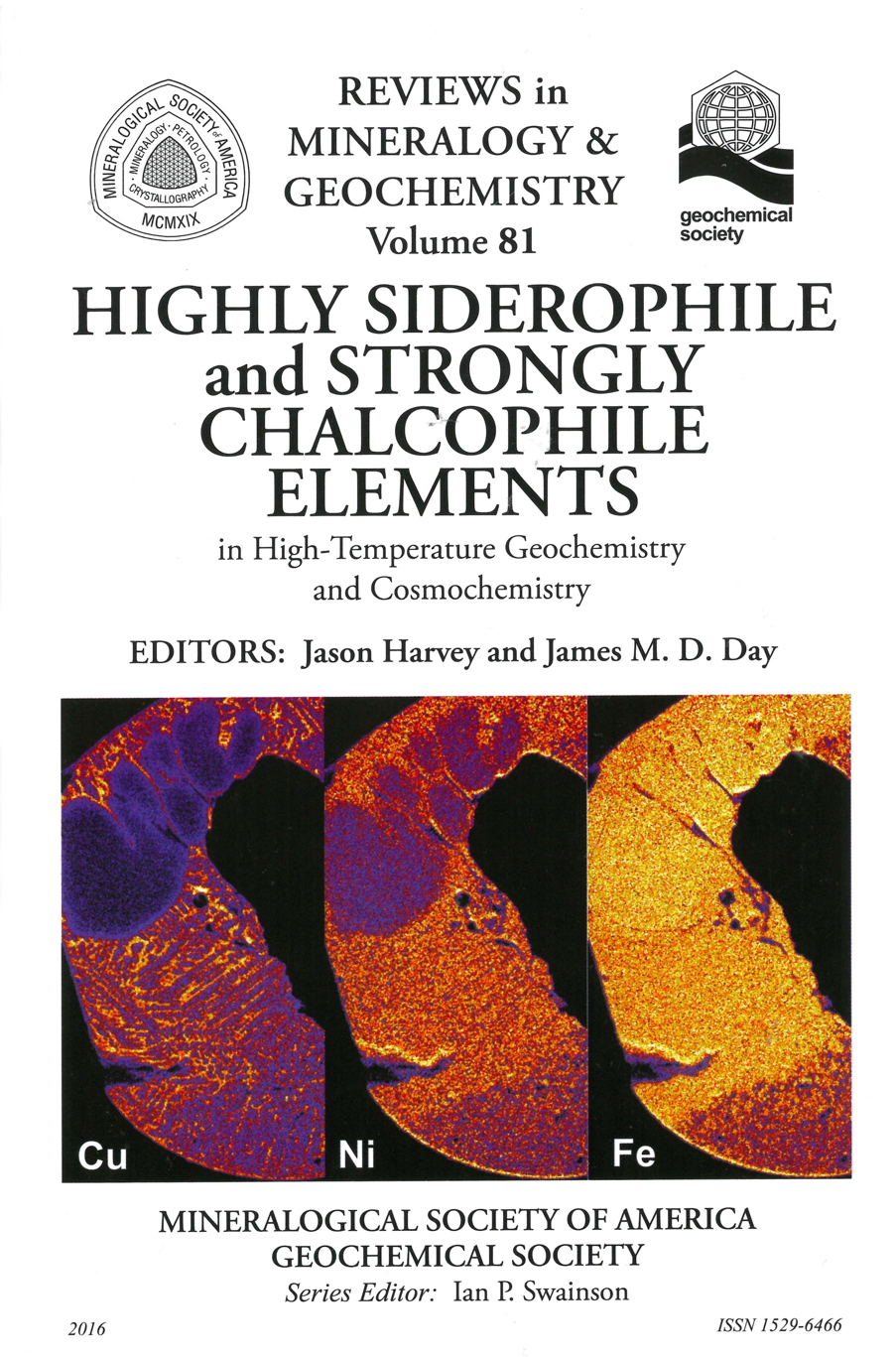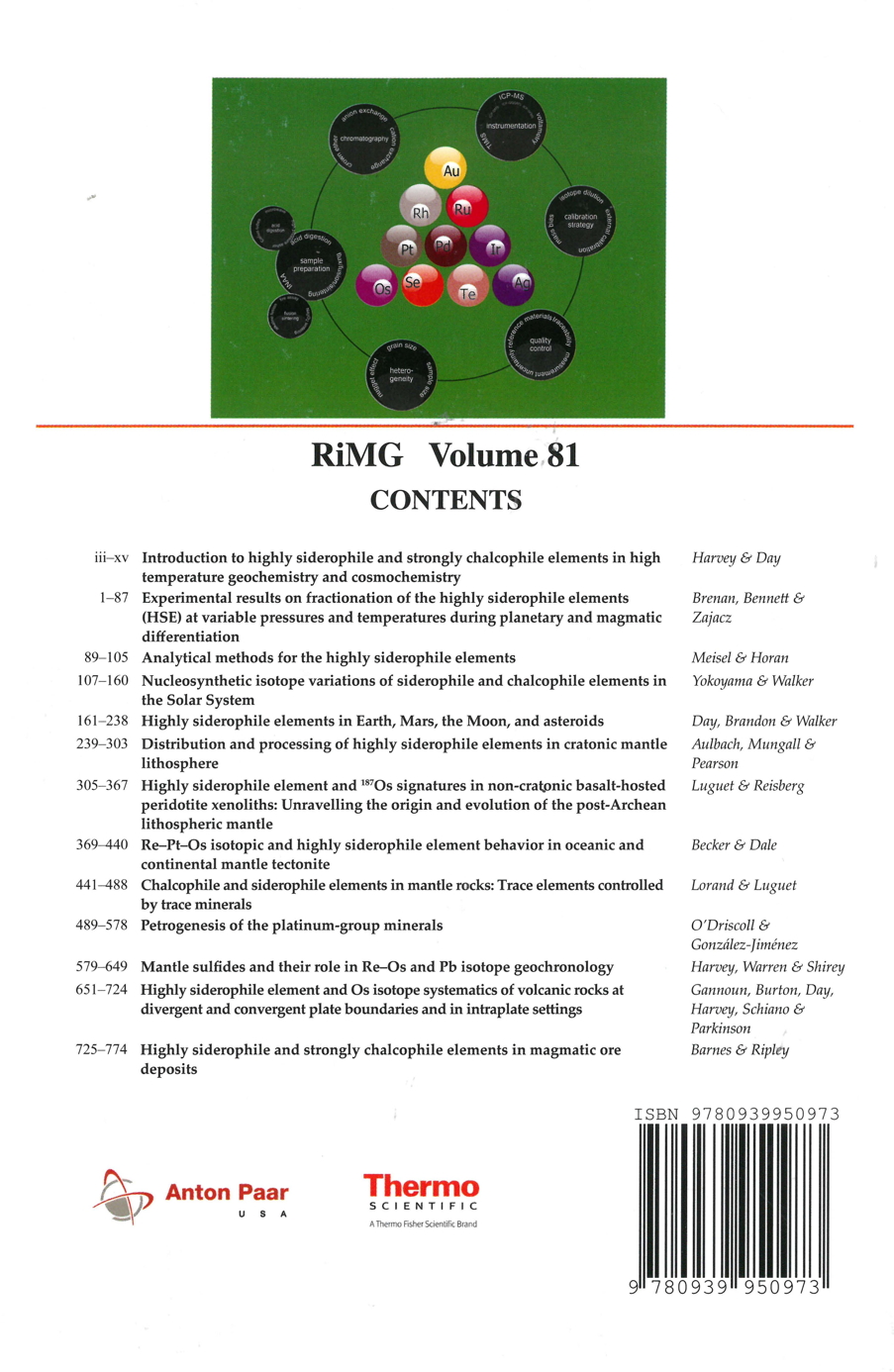

Mineralogical Society of America, Founded December 30, 1919
Order Publications Online (25% discount for MSA, CMS and GS members, except shipping)
MinPubs.org Pay-Per-View GeoScienceWorld


2016, i-xxiii + 774 pages. ISBN 978-0-939950-97-3
In high-temperature geochemistry and cosmochemistry, highly siderophile and strongly chalophile elements can be defined as strongly preferring metal or sulfide, respectively, relative to silicate or oxide phases. The highly siderophile elements (HSE) comprise Re, Os, Ir, Ru, Pt, Rh, Pd, and Au and are defined by their extreme partitioning (>104) into the metallic phase, but will also strongly partition into sulfide phases, in the absence of metal. The HSE are highly refractory, as indicated by their high melting and condensation temperatures and were therefore concentrated in early accreted nebular materials. Within the HSE are the platinum-group elements (PGE), which include the six elements lying in the d-block of the periodic table (groups 8, 9, and 10, periods 5 and 6), i.e., Os, Ir, Ru, Pt, Rh and Pd. These six elements tend to exist in the metallic state, or bond with chalcogens (S, Se, Te) or pnictogens (P, As, Sb, Bi). Rhenium and Au do not necessarily behave as coherently as the PGE, due to their differing electronegativity and oxidation states. For these reasons, a clear definition between the discussion of the PGE and the HSE (PGE, Re and Au) exists in the literature, especially in economic geology, industrial, or bio-medical studies.
The strongly chalcophile elements can be considered to include S, Se, and Te. These three elements are distinguished from other chalcophile elements, such as Cd or Pb, because, like the HSE, they are all in very low abundances in the bulk silicate Earth. By contrast with the HSE, S, Se, and Te all have far lower melting and condensation temperatures, classifying them as highly volatile elements. Moreover, these elements are not equally distributed within chondrite meteorite groups. Since their initial distribution in the Solar nebula, planetary formation and differentiation process have led to large fractionations of the HSE and strongly chalcophile elements, producing a range of absolute and relative inter-element fractionations.
The chemical properties of the HSE, that set them apart from any other elements in the periodic table, have made them geochemical tracers par excellence. As tracers of key processes, the HSE have found application in virtually all areas of the physical Earth sciences. These elements have been used to inform on the nucleosynthetic sources and formation of the Solar System, planetary differentiation, late accretion addition of elements to planets, core-formation and possible core-mantle interaction, crust-mantle partitioning, volcanic processes and outgassing, formation of magmatic, hydrothermal and epithermal ore deposits, ocean circulation, climate-related events, weathering, and biogeochemical cycling. More recently, studies of strongly chalcophile elements are finding a similar range of applications. Their utility lies in the fact that these elements will behave as siderophile or strongly chalcophile elements under reducing conditions, but will also behave as lithophile or atmophile elements under oxidizing conditions, as experienced at the present day Earth's surface.
A key aspect of the HSE is that three long-lived, geologically useful decay systems exist with the HSE as parent (107Pd–107Ag), or parent–daughter isotopes (187Re–187Os and 190Pt–186Os). This volume is dedicated to some of the processes that can be investigated at high-temperatures in planets using the HSE and strongly chalcophile elements.
While this volume is not dedicated to the practical applications of the HSE and strongly chalcophile elements, it would be remiss not to briefly discuss the importance of these elements in society. All of these elements have found important societal use, from the application of Au as a valued commodity in early societies, through to the present-day; the importance of S and Se in biological processes; the discovery and implementation of Pt, Pd, and subsequently other PGE to catalytic oxidation, and the importance of the anti-cancer drug cisplatin (cis-[Pt(NH3)2Cl2]) to anti-tumour treatments. The use of the PGE, most especially Pt, Pd and Rh, in the automotive industry to generate harmless gases has caused some potential collateral effects; the possible environmental impact and human health-risks from available PGE in the environment. An entire volume can (and should!) equally be written on the utility of the HSE and strongly chalcophile elements during low-temperature geochemistry.
In this volume, a number of key areas are reviewed in the use of the HSE and strongly chalcophile elements to investigate fundamental processes in high-temperature geochemistry and cosmochemistry. It is divided into five parts.
The first part of the volume concerns measurements and experiments. Chapter 1, by Brenan et al. (2016), provides an comprehensive overview of experimental constraints applied to understanding HSE partitioning under a range of conditions, including: liquid metal–solid metal; metal– silicate; silicate–melt; monosulfide solid solution (MSS)–sulfide melt; sulfide melt–silicate melt; silicate melt–aqueous fluid–vapor. Chapter 2, by Meisel and Horan (2016) provides a summary of analytical methods, issues specifically associated with measurement of the HSE, and a review of important reference materials.
The second part of the volume concerns the cosmochemical importance of the HSE and strongly chalcophile elements. In their assessment of nucleosynthetic isotopic variations of siderophile and chalcophile elements in Solar System materials, Yokoyama and Walker (2016, Chapter 3) discuss some of the fundamentals of stellar nucleosynthesis, the evidence for nucleosynthetic anomalies in pre-Solar grains, bulk meteorites and individual components of chondrites, ultimately providing a synthesis on the different information afforded by nucleosynthetic anomalies of Ru, Mo, Os, and other siderophile and chalcophile elements. Chapter 4 concerns the HSE in terrestrial bodies, including the Earth, Moon, Mars and asteroidal bodies for which we have materials as meteorites. Day et al. (2016) provide a summary of HSE abundance and 187Os/188Os variations in the range of materials available and a synthesis of initial Solar System composition, evidence for late accretion, and estimates of current planetary mantle composition.
The third part of the volume concerns our understanding of the Earth’s mantle from direct study of mantle materials. In Chapter 5, Aulbach et al. (2016) discuss the importance and challenges associated with understanding HSE in the cratonic mantle, providing new HSE alloy solubility modelling for melt extraction at pressures, temperatures, fO2 and fS2 pertaining to conditions of cratonic mantle lithosphere formation. Luguet and Reisberg (2016) provide similar constraints on non-cratonic mantle in Chapter 6, emphasizing the importance of combined geochemical and petrological approaches to fully understand the histories of mantle peridotites. The information derived from studies of Alpine peridotites, obducted ophiolites and oceanic abyssal peridotites are reviewed in Chapter 7 by Becker and Dale (2016).
The fourth part of the volume focusses on important minerals present in the mantle and crust. Chapter 8 provides a broad overview of mantle chalcophiles. In this chapter, Lorand et al. (2016) emphasise that chalcophile and siderophile elements are important tracers that can be strongly affected by host minerals as a function of sulfur-saturation, redox conditions, pressure, temperature, fugacity of sulfur, and silicate melt compositions. Along a similar theme in Chapter 9, O’Driscoll and Gonzalez-Jimenez (2016) provide an overview of platinum-group minerals (PGM), pointing out that, where present PGM dominate the HSE budget of silicate rocks. Finally in this section, Harvey et al. (2016) examine the importance of Re–Os–Pb isotope dating methods of sulfides for improving our understanding of mantle processes (Chapter 10).
The fifth and final part of the volume considers the important of the HSE for studying volcanic and magmatic processes. In Chapter 11, Gannoun et al. (2016) provide a synthesis of the most abundant forms of volcanism currently operating on Earth, including mid-ocean ridge basalts, volcanism unassociated with plate boundaries, and subduction zone magmatism. The volume is completed in Chapter 12 by Barnes and Ripley (2016), by an appraisal of the obvious importance of magmatic HSE ore formation in Earth's crust.
From the Preface
Jason Harvey, University of Leeds, Leeds, United Kingdom
James M. D. Day, Scripps Institution of Oceanography, La Jolla, California
January 2016
Title Page
p. i Download (114 KB) 
Copyright
p. ii Download (33 KB) 
From the Series Editor
p. iii-v Download (60 KB) 
Preface
p. iii-v
Table of Contents
p. vii-xiv Download (115 KB) 
Chapter 1. Experimental Results on Fractionation of the Highly Siderophile Elements (HSE) at Variable Pressures and Temperatures during Planetary and Magmatic Differentiation
by James M. Brenan, Neil R. Bennett, Zoltan Zajacz, p. 1-88
Table A1. "Summary of previous studies to measure HSE solubility and metal-silicate partitioning" as a MicroSoft Excel file (Download (12 KB)
Table A2. "Summary of mineral-silicate melt partitioning of the HSE" as a MicroSoft Excel file (Download (27 KB)
Table A3. "Summary of sulfide-arsenide-silicate melt partitioning" as a MicroSoft Excel file (Download (34 KB)
Table A4. "Summary of MSS-ISS-sulfide melt partitioning" as a MicroSoft Excel file (Download (26 KB)
Table A5. "A summary of available literature data on Au solubility in magmatic volatiles and co-existing silicate melts and calculated volatile/melt partition coefficients." as a MicroSoft Excel file (Download (47 KB)
Chapter 2. Analytical Methods for the Highly Siderophile Elements
by Thomas Meisel, Mary F. Horan, p. 89-106
Chapter 3. Nucleosynthetic Isotope Variations of Siderophile and Chalcophile Elements in the Solar System
by Tetsuya Yokoyama, Richard J. Walker, p. 107-160 Download (3 MB) 
Chapter 4. Highly Siderophile Elements in Earth, Mars, the Moon, and Asteroids
by James M.D. Day, Alan D. Brandon, Richard J. Walker, p. 161-238 Download (10.8 MB) 
Chapter 5. Distribution and Processing of Highly Siderophile Elements in Cratonic Mantle Lithosphere
by Sonja Aulbach, James E. Mungall, D. Graham Pearson, p. 239-304 Download (9.3 MB) 
Chapter 6. Highly Siderophile Element and 187Os Signatures in Non-cratonic Basalt-hosted Peridotite Xenoliths: Unravelling the Origin and Evolution of the Post-Archean Lithospheric Mantle
by Ambre Luguet, Laurie Reisberg, p. 305-368
Chapter 7. Re–Pt–Os Isotopic and Highly Siderophile Element Behavior in Oceanic and Continental Mantle Tectonites
by Harry Becker, Christopher W. Dale, p. 369-440
Chapter 8. Chalcophile and Siderophile Elements in Mantle Rocks: Trace Elements Controlled By Trace Minerals
by Jean-Pierre Lorand, Ambre Luguet, p. 441-488
Chapter 9. Petrogenesis of the Platinum-Group Minerals
by Brian O’Driscoll, José María González-Jiménez, p. 489-578 Download (8.9 MB) 
Supplementary Table 1 (as an MicroSoft Excel file) PGE mineralization in layered mafic–ultramafic intrusions (LMI) Download (17 KB)
Supplementary Table 2 (as an MicroSoft Excel file) PGE mineralization in ophiolites Download (39 KB)
Supplementary Table 3 (as an MicroSoft Excel file) PGE mineralization in Uralian–Alaskan–Aldan-type complexes (CUAAC) Download (23 KB)
Chapter 10. Mantle Sulfides and their Role in Re–Os and Pb Isotope Geochronology
by Jason Harvey, Jessica M. Warren, Steven B. Shirey, p. 579-651 Download (596 KB) 
Supplementary Information (as an MicroSoft Excel file) Date Sources for Figure 9, page 596: Rhenium and osmium concentrations in BMS grains hosted in abyssal peridotites, continentally derived peridotites and diamonds. Download (242 KB)
Chapter 11. Highly Siderophile Element and Os Isotope Systematics of Volcanic Rocks at Divergent and Convergent Plate Boundaries and in Intraplate Settings
by Abdelmouhcine Gannoun, Kevin W. Burton, James M.D. Day, Jason Harvey, Pierre Schiano, Ian Parkinson, p. 652-724
Chapter 12. Highly Siderophile and Strongly Chalcophile Elements in Magmatic Ore Deposits
by Sarah-Jane Barnes, Edward M. Ripley, p. 725-774